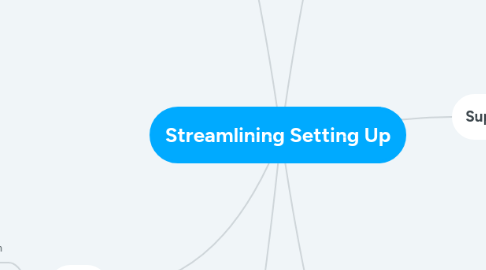
1. Labor
1.1. Local Labor
1.1.1. How the local labor is used
1.1.2. If there is enough labor to accomplish the tasks
1.1.3. Are there too many
1.1.4. Do they need to be more specialized or less
1.2. Company Labor
1.2.1. Support personale
1.2.1.1. Differing opinions
1.2.1.1.1. Not allowing the show supervisors to take over
1.2.1.1.2. Need to step aside
1.2.1.1.3. Need to let go
1.2.1.2. Not available
1.2.1.3. Costly
1.2.2. Touring Labor
1.2.2.1. Over stretched
1.2.2.2. Not available when needed
1.2.2.3. Stressed
1.2.2.4. Tired due to long hours
1.2.2.5. Experienced/Knowledgable
1.2.2.6. Show Specific complexity
1.2.2.6.1. Better understanding of gear
1.2.2.6.2. Coordination of labor
2. Suport Systems
2.1. Establish connections that can be used when problems arise - know the phone numbers and who to call
2.2. Use the support systems the company has in place - be humble and not a hero
2.3. Ask for more when needed - don't wait until its a problem
2.4. Training
2.5. Cross-training
3. Space
3.1. Observe how the space is used throughout the process
3.1.1. Everyone should take part
3.1.2. When one department needs to take over
3.1.3. When changes need to happen or when someone needs to change their process
3.2. Departmental requirements for shared space
3.2.1. Coordination of when which department is using the shared space during which phase of load in/out
3.2.2. Communication
3.2.2.1. Between departments
3.2.2.1.1. Especially when running behind or changing routine
3.2.2.2. Within departments
3.2.2.2.1. Everyone moving in the same direction
3.2.2.3. To the Head Carpenter
3.2.2.3.1. When conflicts arise
3.2.2.3.2. When problems happen
3.2.2.3.3. When a decision needs to be made that affects the whole schedule/show
3.3. Departmental requirements for performance space
3.4. Departmental requirements for storage space
3.4.1. Look at what is actually needed
3.4.2. Streamline the amount of spares
3.4.3. Reorganization of cases to decrease the footprint of gear needed in the building
3.4.3.1. Time is needed to determine what breaks down often
3.4.3.2. Familiarity with gear is needed
3.5. Usage of all space
3.5.1. Creative ways to use space and equipment
3.5.1.1. Use of motors to use space above the side-stage for storage.
3.5.1.1.1. Map out motors, cabling, and controllers for ideal, secondary, and 'oh crap' circumstances
3.5.1.2. Hanging set carts to create another layer of space and keep priority carts in the building for efficient load in/out of scenic pieces
3.5.1.2.1. Prioritize carts in order of truck packs
3.5.1.2.2. Ensure that motors are available
3.5.1.2.3. Coordinate with labor to prioritize certain motors for storage & tear down
3.5.1.3. Hanging prop boats to create additional storage in tight spaces
3.5.1.3.1. Creating boats that can be rigged
3.5.1.3.2. Look at other options for storage - side stage/storage on unused set pieces, storage in prop boxes already owned
3.5.1.3.3. Usage of props carts for props set-up, for ease of load in/load out. Instead of creating something new.
4. Time
4.1. More time working as a team
4.1.1. Observing each other
4.1.2. Self-reflection time
4.2. More time working through the routine
4.2.1. Getting used to how things flow
4.3. Tweaking the routine slowly instead of making big changes
4.3.1. Small changes are better than large ones
5. Equipment
5.1. New LED Carts
5.1.1. Designing better functioning carts
5.1.1.1. Creating a prototype
5.1.1.1.1. Approve prototype
5.1.1.2. Approving fabrication
5.1.1.2.1. Begin Fabrictaion
5.1.1.3. Consulting rental company for ideas
5.1.2. Getting resources approved
5.1.2.1. Requesting bids from companies
5.1.2.1.1. Select company
5.1.2.1.2. Contract with company
5.1.2.2. Requesting time-line for fabrication/production/delivery
5.1.2.2.1. Approve timeline & cost
5.1.3. Providing justification for new carts
5.1.3.1. Observing current carts
5.1.3.2. Questioning users
5.1.3.3. Time the current unloading/loading process
5.1.3.4. Create a cost analysis of the current labor vs projected new labor cost for the new carts
5.1.3.5. Create a space analysis with new carts as compared with old carts - time saved due to space saved - affecting other departments load in
5.2. Understanding of gear
5.2.1. Better understanding of how gear works
5.2.1.1. Time
5.2.1.2. Usage
5.2.2. Familiarity with gear
5.2.2.1. Time
5.2.2.2. Usage
5.3. Order coming off trucks
5.3.1. Changing the order of gear on trucks
5.3.1.1. Create new truck packs & implement until best pack is found to meet all specifications
5.3.2. Changing the truck packs for weight, order
5.3.3. Coordinating how the gear is brought to the space
6. Coordination
6.1. Finding the flow through experimentation
6.1.1. Trying one way a couple times before changing it
6.1.2. Allowing people to get used to a certain way of doing things
6.1.3. Protecting the crew from attacks during the process of changing
6.2. Between departments
6.2.1. Creating a communication system that flows between differing departments
6.2.1.1. Encouraging communication between departments
6.2.2. Allowing the department heads to make decisions amongst themselves to build trust
6.2.2.1. Takes time
6.2.2.2. Requires empowerment
6.2.2.3. Maintain control through trust & respect
6.3. Between general management and touring personale
6.3.1. Crossing the gap distance creates
6.3.2. Maintaining communication through reports, phone calls, check ins
6.3.3. Set-up meetings at touring level and with general management in the office
6.3.4. Coordinate in-person check-ins regularly
6.3.5. Establish trust through honesty
6.3.6. Share emergency situations immediately to coordinate efforts as soon as possible across all departments and throughout the company
6.4. Between Support Companies
6.4.1. Build rapport with rentals companies
6.4.2. Establish time-line for maintenance and share with all parties concerned
